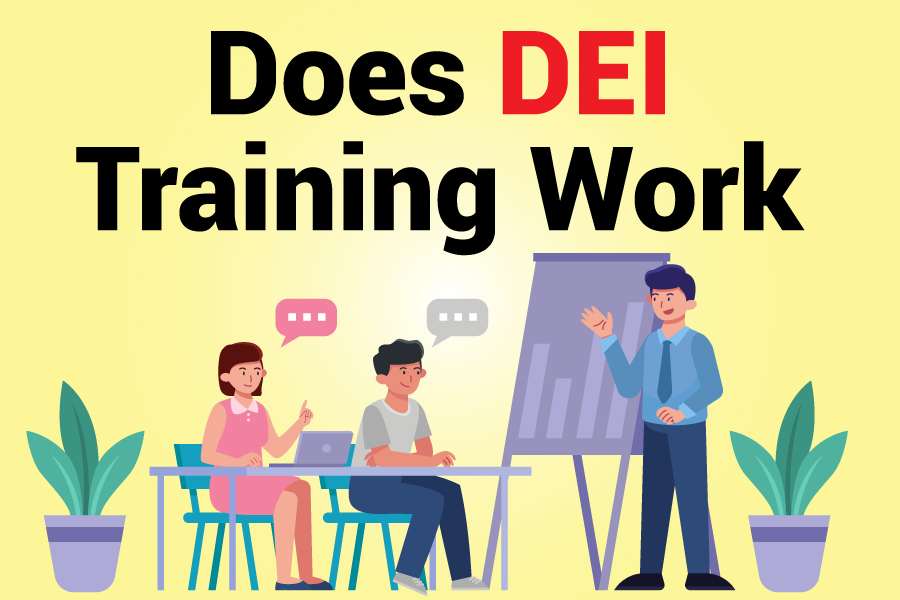Diversity, equity, and inclusion (DEI) training has become essential in today’s workplace, aiming to foster an environment where every employee feels valued and respected. But does it truly work? The effectiveness of DEI training depends on various factors, including the quality of the training, the commitment of leadership, and the integration of DEI principles into daily practices. While DEI training can raise awareness and promote inclusivity, its success largely hinges on ongoing efforts and genuine organizational commitment. This brief explores whether DEI training delivers tangible results, the challenges involved in its implementation, and how businesses can maximize its impact to create a more inclusive and productive work environment. Understanding whether DEI training works is crucial for companies striving to build a culture of respect and equity.
Does Dei Training Work?
Yes, DEI training can support better workplace behavior and inclusivity, but it works best when leadership commits to long-term action and integrates these practices into daily culture.
The Role Of Leadership In The Success Of Dei Training
The success of Diversity, Equity, and Inclusion (DEI) training in any organization largely hinges on the active involvement and commitment of its leadership. While DEI training programs can be meticulously designed and delivered, their effectiveness is significantly amplified when leaders take an active role in championing these initiatives. Here’s why leadership is so crucial in ensuring that DEI training truly works.
Setting the Tone from the Top: Leadership sets the tone for the entire organization. When leaders visibly and vocally support DEI initiatives, it sends a powerful message to all employees that these efforts are not just a checkbox exercise but a core component of the company’s values and culture. Leaders who prioritize DEI create an environment where these principles are respected and integrated into everyday practices, making it clear that diversity, equity, and inclusion are not optional but essential.
Commitment to Continuous Learning: DEI training is not a one-time event but a continuous journey. Leaders who are committed to learning and growing in this area can inspire the same commitment in their teams. When leaders participate in DEI training alongside their employees, they model the importance of the training and demonstrate that everyone, regardless of their position, has room to grow in understanding and implementing DEI principles. This commitment to continuous learning encourages a culture of openness and improvement throughout the organization.
Accountability and Follow-Through: Leadership plays a critical role in holding the organization accountable for the outcomes of DEI training. Without accountability, the lessons from DEI training can quickly fade, leading to minimal real-world impact. Leaders must ensure that there are clear goals and metrics for DEI initiatives and that these are regularly reviewed and assessed. This might include tracking changes in workplace demographics, employee engagement, or incidences of bias and discrimination. By setting measurable objectives and regularly evaluating progress, leaders can ensure that DEI training translates into meaningful, lasting change.
Empowering Middle Management: Leaders must also ensure that middle managers are empowered to reinforce DEI principles in their teams. Middle management is often the bridge between top leadership and the broader workforce, and their buy-in is crucial for the successful implementation of DEI training. Leaders can support this by providing managers with the resources, support, and authority they need to lead DEI efforts effectively within their departments.
The role of leadership in the success of DEI training cannot be overstated. Leaders who actively support, participate in and hold their organizations accountable for DEI initiatives create a culture where diversity, equity, and inclusion are not just theoretical concepts but lived realities. By setting the tone, committing to continuous learning, ensuring accountability, and empowering middle management, leaders can significantly enhance the effectiveness of DEI training and foster a more inclusive and equitable workplace.
How Dei Training Impacts Workplace Culture
Diversity, Equity, and Inclusion (DEI) training has become a pivotal aspect of modern workplace culture. As organizations strive to create more inclusive environments, DEI training plays a crucial role in shaping attitudes, behaviors, and overall workplace dynamics. But how exactly does DEI training impact workplace culture?
Fostering Awareness and Understanding
One of the primary impacts of DEI training is raising awareness about diversity-related issues within the workplace. It helps employees recognize unconscious biases, understand the importance of equity, and appreciate the diverse perspectives that each individual brings to the table. By educating staff on these topics, DEI training can break down barriers of misunderstanding and prejudice, paving the way for a more respectful and inclusive environment.
When employees become more aware of their biases and the unique challenges faced by their colleagues, they are more likely to adjust their behavior and interactions accordingly. This heightened awareness leads to greater empathy and understanding, which are key components of a healthy workplace culture.
Enhancing Communication And Collaboration
Effective DEI training can also improve communication and collaboration within teams. When employees feel respected and included, they are more likely to contribute their ideas and engage fully in their work. DEI training encourages open dialogue about difficult topics, such as race, gender, and identity, which can lead to a more inclusive atmosphere where everyone feels heard and valued.
By promoting a culture of open communication, DEI training helps to dismantle the silos that often exist in diverse workplaces. Employees from different backgrounds can collaborate more effectively when they understand and appreciate each other’s unique perspectives. This, in turn, fosters innovation and creativity, as diverse teams are better equipped to tackle complex problems and generate new ideas.
Reducing Workplace Conflicts
Workplace conflicts often arise from misunderstandings, miscommunications, or biases. DEI training addresses these issues head-on by teaching employees how to navigate cultural differences and interact with colleagues in a respectful and equitable manner. When employees are equipped with the tools to manage diversity-related challenges, conflicts are less likely to escalate and more likely to be resolved constructively.
By reducing conflicts, DEI training contributes to a more harmonious and productive workplace. A culture where differences are celebrated rather than feared creates a positive environment where employees can thrive.
Building a More Inclusive Culture
Ultimately, the goal of DEI training is to build a workplace culture that is genuinely inclusive. This means creating an environment where all employees, regardless of their background, feel valued, respected, and empowered to succeed. DEI training lays the foundation for this type of culture by promoting the values of diversity, equity, and inclusion at every level of the organization.
DEI training has a profound impact on workplace culture by fostering awareness, enhancing communication, reducing conflicts, and building inclusivity. When effectively implemented, DEI training not only improves the day-to-day experiences of employees but also contributes to the overall success and sustainability of the organization. By investing in DEI training, companies can create a culture that attracts and retains top talent, drives innovation, and ultimately, leads to greater business success.
Common Challenges in Implementing DEI Training Programs
DEI training aims to build a more respectful and inclusive workplace, yet many organizations face barriers that limit its impact. One major challenge is employee resistance. Shifts in workplace culture can feel uncomfortable, and some employees may view DEI sessions as unnecessary or even intrusive. This hesitation often leads to low engagement or open pushback. Clear communication and a focus on shared benefits can help ease this tension.
Another obstacle is weak leadership support. When leaders fail to participate or champion the effort, employees assume DEI is not a priority. Visible involvement from management strengthens trust and reinforces the program’s importance.
Token efforts also undermine progress. When DEI is treated as a checkbox activity rather than a genuine commitment, employees quickly sense it, resulting in apathy. Real progress requires consistent follow-through and clear goals.
Limited resources and expertise create further difficulty. Effective DEI programs need proper guidance, skilled facilitators, and tailored content. Global teams add one more layer of complexity, as training must reflect cultural differences to be relevant. By addressing these challenges with intention and sustained effort, organizations can build more meaningful DEI programs that support long-term workplace improvement.
Conclusion
DEI training can support a more inclusive workplace, but its impact depends on honest effort, steady guidance, and strong leadership involvement. When these programs are built into daily culture, they help reduce bias, improve communication, and strengthen team relationships. Still, meaningful progress requires consistent action rather than a single session. Treating DEI as an ongoing commitment creates space for healthier interactions and long-term improvement. This is why answering does dei training work depends on how well it is supported, reinforced, and connected to real workplace goals. With the right approach, DEI training can shape a more respectful environment.
FAQs
Does Diversity Training Backfire?
It can backfire when it feels forced or accusatory. Well-designed training that encourages open dialogue, fits workplace needs, and supports respect reduces resistance and improves results.
Which Type of Diversity Training Is Most Effective?
Interactive, ongoing training with real scenarios and open discussion works best. Leadership support and continuous sessions help reinforce key principles and create stronger long-term impact.
Does DEI Still Exist?
Yes, DEI remains active and important. Many companies use DEI efforts to support fairness, strengthen team culture, improve employee experience, and address evolving workplace needs.
How Often Should Diversity Training Be Updated?
It should be updated regularly to match new challenges, policy changes, and workplace shifts. Frequent adjustments keep the content relevant and more effective.
What Makes Employees More Open to Diversity Training?
Employees respond well when training feels practical, respectful, and connected to real tasks. Supportive leadership and open conversation help increase comfort and participation.













































Leave a Reply